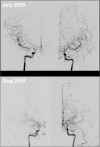Adult Moyamoya Disease: A Burden of Intracranial Stenosis in East Asians?
- PMID: 26125557
- PMCID: PMC4488323
- DOI: 10.1371/journal.pone.0130663
Adult Moyamoya Disease: A Burden of Intracranial Stenosis in East Asians?
Abstract
Background: Both Moyamoya disease (MMD) and intracranial atherosclerotic stenosis (ICAS) are more prevalent in Asians than in Westerners. We hypothesized that a substantial proportion of patients with adult-onset MMD were misclassified as having ICAS, which may in part explain the high prevalence of intracranial atherosclerotic stroke in Asians.
Method: We analyzed 352 consecutive patients with ischemic events within the MCA distribution and relevant intracranial arterial stenosis, but no demonstrable carotid or cardiac embolism sources. Conventional angiography was performed in 249 (70.7%) patients, and the remains underwent MRA. The occurrence of the c.14429G>A (p.Arg4810Lys) variant in ring finger protein 213 (RNF213) was analyzed. This gene was recently identified as a susceptibility gene for MMD in East Asians.
Results: The p.Arg4810Lys variant was observed in half of patients with intracranial stenosis (176 of 352, 50.0%), in no healthy control subjects (n = 51), and in 3.2% of stroke control subjects (4 of 124 patients with other etiologies). The presence of basal collaterals, bilateral involvement on angiography, and absence of diabetes were independently associated with the presence of the RNF213 variant. Among 131 patients who met all three diagnostic criteria and were diagnosed with MMD, three-fourths (75.6%) had this variant. However, a significant proportion of patients who met two criteria (57.7%), one criterion (28.6%), or no criteria (20.0%) also had this variant. Some of them developed typical angiographic findings of MMD on follow-up angiography.
Conclusions: Careful consideration of MMD is needed when diagnosing ICAS because differential therapeutic strategies are required for these diseases and due to the limitations of the current diagnostic criteria for MMD.
Conflict of interest statement
Figures



References
-
- Mak W, Cheng TS, Chan KH, Cheung RT, Ho SL. A possible explanation for the racial difference in distribution of large-arterial cerebrovascular disease: ancestral European settlers evolved genetic resistance to atherosclerosis, but confined to the intracranial arteries. Medical hypotheses. 2005;65(4):637–48. Epub 2005/07/12. 10.1016/j.mehy.2005.05.017 . - DOI - PubMed
Publication types
MeSH terms
Substances
LinkOut - more resources
Full Text Sources
Other Literature Sources
Miscellaneous

